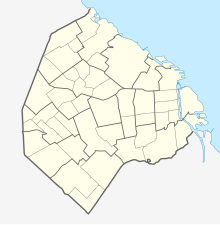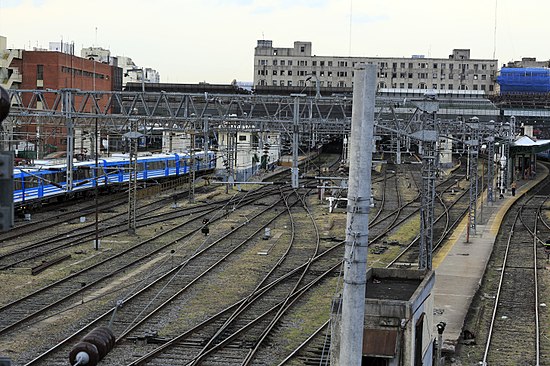Buenos Aires Plaza Constitución train station
Coordinates: 34 ° 37 ′ 40 ″ S , 58 ° 22 ′ 52.7 ″ W.
The Plaza Constitución station , usually just called Constitución , is a suburban and long-distance train station in the Constitución district of the same name in the Argentine capital Buenos Aires . It is located at the intersection of Calle Lima and Avenida Brasil and the Plaza Constitución, which gives it its name . The station, which opened in 1865, is one of five terminal stations in Buenos Aires and at the same time the starting point of the extensive rail network of Ferrocarril General Roca with routes to the provinces of Buenos Aires , La Pampa , Neuquén and Río Negro .
Today the state-private railway company UGOFE operates most of the transport services from Constitución station. The state railway company Ferrobaires is responsible for a few long-distance connections within the province of Buenos Aires . Around 600 trains leave the station every day and the station is used by around 400,000 passengers every day. Beneath the station is the Metro Station Constitución of Subte Line C .
history
The beginnings
Before the Constitución train station was built in its current location, a large farmers' market (Mercado de frutos) was built after 1821 , which was formative and economically beneficial for the southern part of today's capital, Buenos Aires. In 1856 the market was named “Constitución” in memory of the Argentine constitution announced three years earlier and the settlement around the market took over the name.
In 1861, the entrepreneur Eduardo Lumb applied for the construction of a railway line from the farmers' market to Chascomús, about a hundred kilometers away . After Lumb received the permit, the first work on the Gran Ferrocarril al Sud de Buenos Aires began on March 7, 1864. By 1865 a small station with two tracks was built next to the market; the first trains, initially only to Jeppener , ran on August 14, 1865. In December of the same year, Chascomús was connected to the capital.
First new building

Over the years, an ever larger district developed around the station, which grew mainly due to the influx of European immigrants. In 1885, the then Intendente Torcuato de Alvear demolished the market and built today's Plaza Constitución in its place . At the same time, through the acquisition of smaller railway companies and the construction of new lines, additional connections to the south of Argentina went into operation, including to the Atlantic coast to Bahía Blanca (Línea Azul) . For this reason, the station was demolished and replaced in 1898 by a Victorian building by the London architects Strong & Parr, which is architecturally based on the Chàteau von Maisons-Laffitte . But even this station was not enough. With the opening of the connection to the seaside resort of Mar del Plata , the number of passengers continued to rise, so that from 1906 to 1907 and 1912 the station was expanded to include additional platforms at the eastern end.
Second new building
In 1922 the plan arose to completely demolish and rebuild the station. The foundation stone for the new building that still exists today was laid on September 19, 1925 by Edward VIII , then Prince of Wales , during his state visit to Argentina. A train station with a total of fourteen tracks and a large vestibule similar to New York's Grand Central Terminal was created under the direction of the English architect Paul Bell Chambers and the American Louis Newberry Thomas.
With the nationalization of all railways in 1943, henceforth known as Ferrocarriles Argentinos , the station building also came to the state. Under the Perón government, all Argentine (partial) railway networks were also named after well-known and famous Argentines. The Gran Ferrocarril al Sud de Buenos Aires , mostly just Ferrocarril del Sud , was named after the two-time Argentine President Julio Argentino Roca and is still known today as Ferrocarril General Roca .
Development until today
After the state-owned Ferrocarriles Argentinos were gradually broken up and privatized in the early 1990s, the private railway company Metropolitano took over the operation of the suburban trains on the Ferrocarril General Roca on May 1, 1994 . Most of the long-distance connections of the Ferrocarriles Argentinos were canceled without replacement, only a few connections within the province of Buenos Aires were taken over by the railway company Ferrobaires , which is also state-owned but under the leadership of the province of Buenos Aires .
Over the years, the Argentine state only made limited investments in the Argentine railway network, so that gradually more and more damage to the station construction could be seen. With the privatization of the railway, the maintenance of the station went to the Metropolitano , which planned the renovation in 1999 with the help of the city government of Buenos Aires. This was taken over by the subsidiary of Metropolitano, Desarrollo de Comercios SA. Although the work was supposed to be finished in November 2000, it made slow progress and was ultimately not completed because the company ran into financial difficulties and had laid off most of the employees. The renovation of the station was only completed on October 1, 2005 after negotiations with the city government and several months of standstill on the construction site. This included, among other things, a complete modernization of the station (installation of elevators and escalators), a renewal of the historical facade and the station hall as well as new rooms for shops and restaurants. The total cost was 20 million Argentine pesos (about 5.7 million euros at the time).
On May 15, 2007, a riot broke out in the station after numerous passengers repeatedly protested against what they believed to be the poor service provided by the Metropolitano railway company. Serious property damage occurred to the station building itself, several wagons of the suburban trains were set on fire. The police counted a total of 21 injured and took 16 people into custody. The Argentine government took the event as an opportunity to withdraw the concession for the suburban railway networks Roca and Belgrano Sur on May 22, 2007 due to the repeated poor service of the railway company Metropolitano . On July 7, 2007, the state-private UGOFE , which had been operating the route between Retiro station and Pilar (Línea San Martín) since 2004 , took over operations on both subnets.
There are currently plans to electrify the line to La Plata (via both Quilmes and Temperley ). This would also include raising all platforms on the lines, which would consequently also entail structural changes at the Constitución station.
Individual evidence
- ^ A b Constitución, un shopping , [Constitución, a shopping center], La Nación , September 30, 2005
- ↑ History of the station on historiadebuenosaires.arquitecturaliquida.com ( Memento of the original from April 20, 2009 in the Internet Archive ) Info: The archive link was automatically inserted and not yet checked. Please check the original and archive link according to the instructions and then remove this notice. , accessed May 20, 2010
- ↑ Plaza Constitución espera un milagro , [Plaza Constitución awaits a miracle], La Nación , January 20, 2002
- ↑ Se reanudan las obras en Constitución , [Work at Constitución station is resumed], La Nación , July 20, 2002
- ^ Hubo furia tras la demora en los trenes , [Uprisings over train delays], La Nación , May 16, 2007
- ^ Noche de furia en Plaza Constitución: pasajeros incendiaron varios vagones , [Violent night in the Constitución station: passengers set fire to several trains], Clarín, September 20, 2006
- ↑ "Decree 591/2007 sobre Servicios de Ferroviarios Pasajeros"
- ↑ "Decree 592/2007 sobre Servicios de Ferroviarios Pasajeros"
- ↑ Antonio Rossi: In the course of the elections, the electrification of the Roca railway is pushed ahead , Clarín , April 12, 2009




